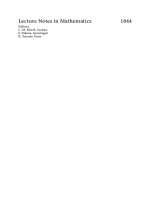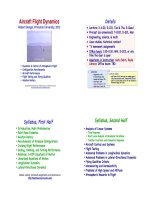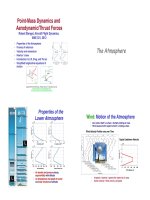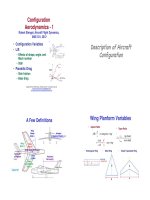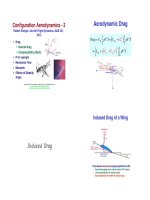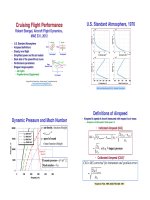Aircraft Flight Dynamics Robert F. Stengel Lecture6 Cruising Flight Performance
Bạn đang xem bản rút gọn của tài liệu. Xem và tải ngay bản đầy đủ của tài liệu tại đây (7.13 MB, 15 trang )
Cruising Flight Performance
Robert Stengel, Aircraft Flight Dynamics,
MAE 331, 2012!
Copyright 2012 by Robert Stengel. All rights reserved. For educational use only.!
/> />• U.S. Standard Atmosphere"
• Airspeed definitions"
• Steady, level flight"
• Simplified power and thrust models"
• Back side of the power/thrust curve"
• Performance parameters"
• Breguet range equation"
– Jet engine"
– Propeller-driven (Supplement)"
U.S. Standard Atmosphere, 1976"
/>Dynamic Pressure and Mach Number"
ρ
= air density, functionof height
=
ρ
sealevel
e
−
β
h
a = speed of sound
= linear functionof height
Dynamic pressure = q
ρ
V
2
2
Mach number = V a
Definitions of Airspeed"
• Indicated Airspeed (IAS)"
• Calibrated Airspeed (CAS)*"
• Airspeed is speed of aircraft measured with respect to air mass"
– Airspeed = Inertial speed if wind speed = 0"
IAS = 2 p
stagnation
− p
ambient
( )
ρ
SL
=
2 p
total
− p
static
( )
ρ
SL
=
2q
c
ρ
SL
, with q
c
impact pressure
CAS = IAS corrected for instrument and position errors
=
2 q
c
( )
corr−1
ρ
SL
* Kayton & Fried, 1969; NASA TN-D-822, 1961!
Definitions of Airspeed"
• True Airspeed (TAS)*"
• Equivalent Airspeed (EAS)*"
• Airspeed is speed of aircraft measured with respect to air mass"
– Airspeed = Inertial speed if wind speed = 0"
EAS = CAS corrected for compressibility effects =
2 q
c
( )
corr−2
ρ
SL
V TAS = EAS
ρ
SL
ρ
(z)
= IAS
corrected
ρ
SL
ρ
(z)
• Mach number"
M =
TAS
a
* Kayton & Fried, 1969; NASA TN-D-822, 1961!
Air Data System"
Air Speed Indicator!
Altimeter!
Vertical Speed Indicator!
Kayton & Fried, 1969!
• Subsonic speed: no shock wave ahead of pitot tube"
• Supersonic speed: normal shock wave ahead of pitot tube"
Dynamic and Impact Pressure"
• Dynamic pressure also can be expressed in terms of Mach
number and static (ambient) pressure"
q
ρ
V
2
2 : Dynamic pressure
q
c
= p
total
− p
static
: Impact pressure
p
stat
z
( )
=
ρ
amb
z
( )
RT z
( )
[Ideal gas law, R = 287.05 J/kg-°K]
a z
( )
=
γ
RT z
( )
[Speed of sound, T = absolute temperature, °K,
γ
= 1.4]
M =V a [Mach number]
q
ρ
amb
z
( )
V
2
2 =
γ
2
p
stat
z
( )
M
2
• In incompressible flow, dynamic pressure = impact pressure"
Substituting!
• In subsonic, isentropic compressible flow"
• Impact pressure is"
p
total
z
( )
p
static
z
( )
= 1+
γ
−1
2
M
2
#
$
%
&
'
(
γ γ
−1
( )
q
c
p
total
z
( )
− p
static
z
( )
"
#
$
%
= p
static
z
( )
1+ 0.2M
2
( )
3.5
−1
"
#
&
$
%
'
Compressibility Effects on
Impact Pressure"
• In supersonic, isentropic compressible flow, impact
pressure is"
q
c
= p
static
z
( )
1+
γ
2
M
2
γ
+1
( )
2
4
γ
−
2
γ
−1
( )
M
2
#
$
%
%
%
%
&
'
(
(
(
(
1
γ
−1
( )
−1
)
*
+
+
,
+
+
-
.
+
+
/
+
+
Flight in the
Vertical Plane
Longitudinal Variables!
Longitudinal Point-Mass
Equations of Motion"
V =
C
T
cos
α
− C
D
( )
1
2
ρ
V
2
S −mg sin
γ
m
≈
C
T
− C
D
( )
1
2
ρ
V
2
S −mg sin
γ
m
γ
=
C
T
sin
α
+ C
L
( )
1
2
ρ
V
2
S −mg cos
γ
mV
≈
C
L
1
2
ρ
V
2
S −mg cos
γ
mV
h = −
z = −v
z
= V sin
γ
r =
x = v
x
= V cos
γ
V = velocity
γ
= flight path angle
h = height (altitude)
r = range
• Assume thrust is aligned with the velocity
vector (small-angle approximation for
α
)"
• Mass = constant"
Steady, Level Flight"
0 =
C
T
− C
D
( )
1
2
ρ
V
2
S
m
0 =
C
L
1
2
ρ
V
2
S − mg
mV
h = 0
r = V
• Flight path angle = 0"
• Altitude = constant"
• Airspeed = constant"
• Dynamic pressure = constant"
• Thrust = Drag"
• Lift = Weight"
Subsonic Lift and Drag
Coefficients"
C
L
= C
L
o
+ C
L
α
α
C
D
= C
D
o
+
ε
C
L
2
• Lift coefficient"
• Drag coefficient"
• Subsonic flight, below
critical Mach number "
C
L
o
, C
L
α
, C
D
o
,
ε
≈ constant
Subsonic!
Incompressible!
Power and Thrust"
• Propeller"
• Turbojet"
Power = P = T × V = C
T
1
2
ρ
V
3
S ≈ independent of airspeed
Thrust = T = C
T
1
2
ρ
V
2
S ≈ independent of airspeed
• Throttle Effect"
T = T
max
δ
T = C
T
max
δ
TqS, 0 ≤
δ
T ≤ 1
Typical Effects of Altitude and
Velocity on Power and Thrust"
• Propeller"
• Turbojet"
Thrust of a Propeller-
Driven Aircraft"
T =
η
P
η
I
P
engine
V
=
η
net
P
engine
V
• Efficiencies decrease with airspeed"
• Engine power decreases with altitude"
– Proportional to air density, w/o supercharger"
• With constant rpm, variable-pitch propeller"
where
η
P
= propeller efficiency
η
I
= ideal propulsive efficiency
η
net
max
≈ 0.85 − 0.9
• Advance Ratio"
J =
V
nD
from McCormick!
Propeller Efficiency,
η
P
,
and Advance Ratio, J"
Effect of propeller-blade pitch angle!
where
V = airspeed, m / s
n = rotation rate, revolutions / s
D = propeller diameter, m
Thrust of a
Turbojet
Engine"
T =
mV
θ
o
θ
o
−1
#
$
%
&
'
(
θ
t
θ
t
−1
#
$
%
&
'
(
τ
c
−1
( )
+
θ
t
θ
o
τ
c
*
+
,
-
.
/
1/2
−1
0
1
2
3
2
4
5
2
6
2
• Little change in thrust with airspeed below M
crit
"
• Decrease with increasing altitude"
where
m =
m
air
+
m
fuel
θ
o
=
p
stag
p
ambient
"
#
$
%
&
'
(
γ
−1)/
γ
;
γ
= ratio of specific heats ≈1.4
θ
t
=
turbine inlet temperature
freestream ambient temperature
"
#
$
%
&
'
τ
c
=
compressor outlet temperature
compressor inlet temperature
"
#
$
%
&
'
from Kerrebrock!
Performance Parameters"
• Lift-to-Drag Ratio"
• Load Factor"
L
D
=
C
L
C
D
n =
L
W
=
L
mg
,"g"s
• Thrust-to-Weight Ratio"
T
W
=
T
mg
,"g"s
• Wing Loading"
W
S
, N m
2
or lb ft
2
Steady, Level Flight
Trimmed C
L
and
α
"
• Trimmed lift
coefficient, C
L
"
– Proportional to
weight"
– Decrease with V
2
"
– At constant
airspeed, increases
with altitude"
• Trimmed angle of attack,
α
"
– Constant if dynamic pressure
and weight are constant"
– If dynamic pressure decreases,
angle of attack must increase"
W = C
L
trim
qS
C
L
trim
=
1
q
W S
( )
=
2
ρ
V
2
W S
( )
=
2 e
β
h
ρ
0
V
2
#
$
%
&
'
(
W S
( )
α
trim
=
2W
ρ
V
2
S − C
L
o
C
L
α
=
1
q
W S
( )
− C
L
o
C
L
α
Thrust Required for
Steady, Level Flight"
• Trimmed thrust"
T
trim
= D
cruise
= C
D
o
1
2
ρ
V
2
S
"
#
$
%
&
'
+
ε
2W
2
ρ
V
2
S
• Minimum required thrust conditions"
∂
T
trim
∂
V
= C
D
o
ρ
VS
( )
−
4
ε
W
2
ρ
V
3
S
= 0
Necessary Condition
= Zero Slope!
Parasitic Drag!
Induced Drag!
Necessary and Sufficient
Conditions for Minimum
Required Thrust "
∂
T
trim
∂
V
= C
D
o
ρ
VS
( )
−
4
ε
W
2
ρ
V
3
S
= 0
Necessary Condition = Zero Slope!
Sufficient Condition for a Minimum = Positive Curvature when slope = 0!
∂
2
T
trim
∂
V
2
= C
D
o
ρ
S
( )
+
12
ε
W
2
ρ
V
4
S
> 0
(+)"
(+)"
Airspeed for
Minimum Thrust in
Steady, Level Flight"
• Fourth-order equation for velocity"
– Choose the positive root"
∂
T
trim
∂
V
= C
D
o
ρ
VS
( )
−
4
ε
W
2
ρ
V
3
S
= 0
V
MT
=
2
ρ
W
S
"
#
$
%
&
'
ε
C
D
o
• Satisfy necessary
condition"
V
4
=
4
ε
C
D
o
ρ
2
#
$
%
%
&
'
(
(
W S
( )
2
P-51 Mustang
Minimum-Thrust
Example"
V
MT
=
2
ρ
W
S
"
#
$
%
&
'
ε
C
D
o
=
2
ρ
1555.7
( )
0.947
0.0163
=
76.49
ρ
m / s
Wing Span = 37 ft (9.83 m)
Wing Area = 235 ft
2
(21.83 m
2
)
Loaded Weight = 9,200 lb (3, 465 kg)
C
D
o
= 0.0163
ε
= 0.0576
W / S = 39.3 lb / ft
2
(1555.7 N / m
2
)
Altitude, m
Air Density,
kg/m^3
VMT, m/s
0 1.23 69.11
2,500 0.96 78.20
5,000 0.74 89.15
10,000 0.41 118.87
Airspeed for minimum thrust!
Lift Coefficient in
Minimum-Thrust
Cruising Flight"
V
MT
=
2
ρ
W
S
"
#
$
%
&
'
ε
C
D
o
C
L
MT
=
2
ρ
V
MT
2
W
S
"
#
$
%
&
'
=
C
D
o
ε
• Airspeed for minimum thrust"
• Corresponding lift coefficient"
Power Required for
Steady, Level Flight"
• Trimmed power"
P
trim
= T
trim
V = D
cruise
V = C
D
o
1
2
ρ
V
2
S
"
#
$
%
&
'
+
2
ε
W
2
ρ
V
2
S
)
*
+
,
-
.
V
• Minimum required power conditions"
∂
P
trim
∂
V
= C
D
o
3
2
ρ
V
2
S
( )
−
2
ε
W
2
ρ
V
2
S
= 0
Parasitic Drag!
Induced Drag!
Airspeed for Minimum
Power in Steady,
Level Flight"
• Fourth-order equation for velocity"
– Choose the positive root"
V
MP
=
2
ρ
W
S
"
#
$
%
&
'
ε
3C
D
o
• Satisfy necessary condition"
∂
P
trim
∂
V
= C
D
o
3
2
ρ
V
2
S
( )
−
2
ε
W
2
ρ
V
2
S
= 0
• Corresponding lift and
drag coefficients"
C
L
MP
=
3C
D
o
ε
C
D
MP
= 4C
D
o
Achievable Airspeeds in Cruising Flight"
• Two equilibrium airspeeds for a given thrust or power setting"
– Low speed, high C
L
, high
α#
– High speed, low C
L
, low
α#
• Achievable airspeeds between minimum and maximum values
with maximum thrust or power
#
Back Side of the
Thrust Curve"
Achievable Airspeeds
for Jet in Cruising Flight"
T
avail
= C
D
o
1
2
ρ
V
2
S
"
#
$
%
&
'
+
2
ε
W
2
ρ
V
2
S
C
D
o
1
2
ρ
V
4
S
"
#
$
%
&
'
−T
avail
V
2
+
2
ε
W
2
ρ
S
= 0
V
4
−
T
avail
V
2
C
D
o
ρ
S
+
4
ε
W
2
C
D
o
ρ
S
( )
2
= 0
• Thrust = constant
#
• Solutions for V can be put in quadratic form and solved easily
#
€
x ≡ V
2
; V = ± x
ax
2
+ bx + c = 0
x = −
b
2
±
b
2
$
%
&
'
(
)
2
− c, a = 1
• 4
th
-order algebraic
equation for V
#
• With increasing altitude, available thrust decreases, and range of
achievable airspeeds decreases"
• Stall limitation at low speed"
• Mach number effect on lift and drag increases thrust required at high speed"
Thrust Required and Thrust
Available for a Typical Bizjet"
Typical Simplified Jet Thrust Model!
T
max
(h) = T
max
(SL)
ρ
−nh
ρ
(SL)
, n < 1
= T
max
(SL)
ρ
−
β
h
ρ
(SL)
$
%
&
'
(
)
x
≡ T
max
(SL)
σ
x
where
σ
=
ρ
−
β
h
ρ
(SL)
, n or x is an empirical constant
Thrust Required and Thrust
Available for a Typical Bizjet"
Typical Stall!
Limit!
Maximum Lift-to-Drag Ratio"
C
L
( )
L / D
max
=
C
D
o
ε
= C
L
MT
L
D
=
C
L
C
D
=
C
L
C
D
o
+
ε
C
L
2
∂
C
L
C
D
( )
∂
C
L
=
1
C
D
o
+
ε
C
L
2
−
2
ε
C
L
2
C
D
o
+
ε
C
L
2
( )
2
= 0
• Satisfy necessary condition for a maximum"
• Lift-to-drag ratio"
• Lift coefficient for maximum L/D
and minimum thrust are the same"
Airspeed, Drag Coefficient, and
Lift-to-Drag Ratio for L/D
max
"
V
L / D
max
= V
MT
=
2
ρ
W
S
"
#
$
%
&
'
ε
C
D
o
C
D
( )
L / D
max
= C
D
o
+ C
D
o
= 2C
D
o
L / D
( )
max
=
C
D
o
ε
2C
D
o
=
1
2
ε
C
D
o
• Maximum L/D depends only on induced drag factor
and zero-
α
drag coefficient"
Airspeed!
Drag !
Coefficient!
Maximum !
L/D!
Lift-Drag Polar for a
Typical Bizjet"
• L/D equals slope of line drawn from the origin"
– Single maximum for a given polar"
– Two solutions for lower L/D (high and low airspeed)"
– Available L/D decreases with Mach number"
• Intercept for L/D
max
depends only on
ε
and zero-lift drag"
Note different scales
for lift and drag!
P-51 Mustang
Maximum L/D
Example"
V
L / D
max
= V
MT
=
76.49
ρ
m / s
Wing Span = 37 ft (9.83 m)
Wing Area = 235 ft (21.83 m
2
)
Loaded Weight = 9, 200 lb (3, 465 kg)
C
D
o
= 0.0163
ε
= 0.0576
W / S = 1555.7 N / m
2
C
L
( )
L / D
max
=
C
D
o
ε
= C
L
MT
= 0.531
C
D
( )
L / D
max
= 2C
D
o
= 0.0326
L / D
( )
max
=
1
2
ε
C
D
o
= 16.31
Altitude, m
Air Density,
kg/m^3
VMT, m/s
0 1.23 69.11
2,500 0.96 78.20
5,000 0.74 89.15
10,000 0.41 118.87
Optimal Cruising Flight
Cruising Range and
Specific Fuel Consumption"
0 =
C
T
− C
D
( )
1
2
ρ
V
2
S
m
0 =
C
L
1
2
ρ
V
2
S − mg
mV
h = 0
r = V
• Thrust = Drag"
• Lift = Weight"
• Specific fuel consumption, SFC = c
P
or c
T
"
• Propeller aircraft"
• Jet aircraft"
w
f
= −c
P
P proportional to power
[ ]
w
f
= −c
T
T proportional to thrust
[ ]
where
w
f
= fuel weight
€
c
P
:
kg s
kW
or
lb s
HP
c
T
:
kg s
kN
or
lb s
lbf
Breguet Range Equation
for Jet Aircraft"
dr
dw
=
dr dt
dw dt
=
r
w
=
V
−c
T
T
( )
= −
V
c
T
D
= −
L
D
"
#
$
%
&
'
V
c
T
W
dr = −
L
D
"
#
$
%
&
'
V
c
T
W
dw
• Rate of change of range with respect to weight of fuel burned"
• Range traveled"
Range = R = dr
0
R
∫
= −
L
D
#
$
%
&
'
(
V
c
T
#
$
%
&
'
(
W
i
W
f
∫
dw
w
Louis Breguet,
1880-1955!
Breguet Range
Equation for Jet Aircraft"
• For constant true airspeed, V = V
cruise!
R = −
L
D
"
#
$
%
&
'
V
cruise
c
T
"
#
$
%
&
'
ln w
( )
W
i
W
f
=
L
D
"
#
$
%
&
'
V
cruise
c
T
"
#
$
%
&
'
ln
W
i
W
f
"
#
$
$
%
&
'
'
=
C
L
C
D
"
#
$
%
&
'
V
cruise
c
T
"
#
$
%
&
'
ln
W
i
W
f
"
#
$
$
%
&
'
'
Dassault !
Etendard IV!
Maximum Range of a
Jet Aircraft Flying at
Constant True Airspeed"
∂
R
∂
C
L
=
∂
VC
L
C
D
( )
∂
C
L
= 0 leading to C
L
MR
=
C
D
o
3
ε
• For given initial and final weight, range is maximized when
product of V and L/D is maximized"
• Breguet range equation for constant V = V
cruise
"
R = V
cruise
C
L
C
D
!
"
#
$
%
&
1
c
T
!
"
#
$
%
&
ln
W
i
W
f
!
"
#
#
$
%
&
&
! V
cruise
as fast as possible"
!
ρ
as small as possible"
! h as high as possible"
C
L
MR
=
C
D
o
3
ε
: Lift Coefficient for Maximum Range
Maximum Range of a Jet Aircraft
Flying at Constant True Airspeed"
• Because weight decreases as fuel burns, and V is
assumed constant, altitude must increase to hold C
L
constant at its best value (cruise-climb)"
C
L
MR
q t
( )
S = W t
( )
⇒
q t
( )
=
1
2
ρ
t
( )
V
cruise
2
=
W t
( )
S
"
#
$
%
&
'
3
ε
C
D
o
⇒
ρ
(t) =
ρ
o
e
−
β
h(t )
=
2
V
cruise
2
W (t)
S
$
%
&
'
(
)
3
ε
C
D
o
⇒
h W t
( )
,V
cruise
!
"
#
$
Maximum Range of a
Jet Aircraft Flying at
Constant Altitude"
• Range is maximized when "
Range = −
C
L
C
D
"
#
$
%
&
'
1
c
T
"
#
$
%
&
'
2
C
L
ρ
S
W
i
W
f
∫
dw
w
1 2
=
C
L
C
D
"
#
$
$
%
&
'
'
2
c
T
"
#
$
%
&
'
2
ρ
S
W
i
1 2
−W
f
1 2
( )
V
cruise
t
( )
=
2W t
( )
C
L
ρ
h
fixed
( )
S
• At constant altitude"
C
L
C
D
!
"
#
#
$
%
&
&
= maximum and
ρ
= minimum
h = maximum
(
)
*
+
*
! Cruise-climb usually violates air
traffic control rules"
! Constant-altitude cruise does not"
! Compromise: Step climb from
one allowed altitude to the next"
Next Time:
Gliding, Climbing, and
Turning Flight
Reading
Flight Dynamics, 130-141, 147-155
Virtual Textbook, Parts 6,7
Supplemental Ma"rial#
Air Data Probes"
Redundant pitot tubes on F-117"
Total and static temperature probe"
Total and static pressure ports
on Concorde"
Stagnation/static pressure probe"
Redundant pitot
tubes on Fouga
Magister"
Cessna 172 pitot tube"
X-15 Q Ball"
Flight Testing Instrumentation"
• Air data measurement far from
disturbing effects of the aircraft"
z =
p
stagnation
,T
stagnation
p
static
,T
static
α
B
β
B
#
$
%
%
%
%
%
&
'
(
(
(
(
(
=
Stagnation pressure and temperature
Static pressure and temperature
Angle of attack
Sideslip angle
#
$
%
%
%
%
%
&
'
(
(
(
(
(
Trailing Tail Cones for Accurate
Static Pressure Measurement"
• Air data measurement far from disturbing
effects of the aircraft"
Air Data Instruments
(Steam Gauges)"
Altimeter"
1 knot = 1 nm / hr
= 1.151 st. mi. / hr = 1.852 km / hr
Calibrated Airspeed Indicator"
Modern Aircraft Cockpit Panels"
Cirrus SR-22 Panel"
Boeing 777 Glass Cockpit"
Air Data Computation for
Subsonic Aircraft"
Kayton & Fried, 1969!
Air Data Computation for
Supersonic Aircraft"
Kayton & Fried, 1969!
The Mysterious Disappearance of
Air France Flight 447 (Airbus A330-200)"
/>BEA Interim Reports, 7/2/2009 & 11/30/2009!
o/en/enquetes/flight.af.447/flight.af.447.php!
Suspected Failure of
Thales Heated Pitot Probe!
Visual examination showed that the airplane
was not destroyed in flight; it appears to have
struck the surface of the sea in level flight with
high vertical acceleration.!
Achievable Airspeeds
in Propeller-Driven
Cruising Flight"
P
avail
= T
avail
V
V
4
−
P
avail
V
C
D
o
ρ
S
+
4
ε
W
2
C
D
o
ρ
S
( )
2
= 0
• Power = constant
#
• Solutions for V cannot be put in quadratic form; solution is
more difficult, e.g., Ferraris method
#
aV
4
+ 0
( )
V
3
+ 0
( )
V
2
+ dV + e = 0
• Best bet: roots in MATLAB
#
Back Side of
the Power
Curve"
Breguet Range Equation
for Propeller-Driven
Aircraft"
dr
dw
=
r
w
=
V
−c
P
P
( )
= −
V
c
P
TV
= −
V
c
P
DV
= −
L
D
"
#
$
%
&
'
1
c
P
W
• Rate of change of range with respect to weight of fuel burned"
• Range traveled"
Range = R = dr
0
R
∫
= −
L
D
#
$
%
&
'
(
1
c
P
#
$
%
&
'
(
W
i
W
f
∫
dw
w
Breguet 890 Mercure!
Breguet Range Equation
for Propeller-Driven
Aircraft"
• For constant true airspeed, V = V
cruise!
R = −
L
D
"
#
$
%
&
'
1
c
P
"
#
$
%
&
'
ln w
( )
W
i
W
f
=
C
L
C
D
"
#
$
%
&
'
1
c
P
"
#
$
%
&
'
ln
W
i
W
f
"
#
$
$
%
&
'
'
• Range is maximized when "
C
L
C
D
!
"
#
$
%
&
= maximum =
L
D
( )
max
Breguet Atlantique!
P-51 Mustang
Maximum Range
(Internal Tanks only)"
W = C
L
trim
qS
C
L
trim
=
1
q
W S
( )
=
2
ρ
V
2
W S
( )
=
2 e
β
h
ρ
0
V
2
#
$
%
&
'
(
W S
( )
R =
C
L
C
D
!
"
#
$
%
&
max
1
c
P
!
"
#
$
%
&
ln
W
i
W
f
!
"
#
#
$
%
&
&
= 16.31
( )
1
0.0017
!
"
#
$
%
&
ln
3, 465 + 600
3, 465
!
"
#
$
%
&
=1,530 km (825 nm
( )
